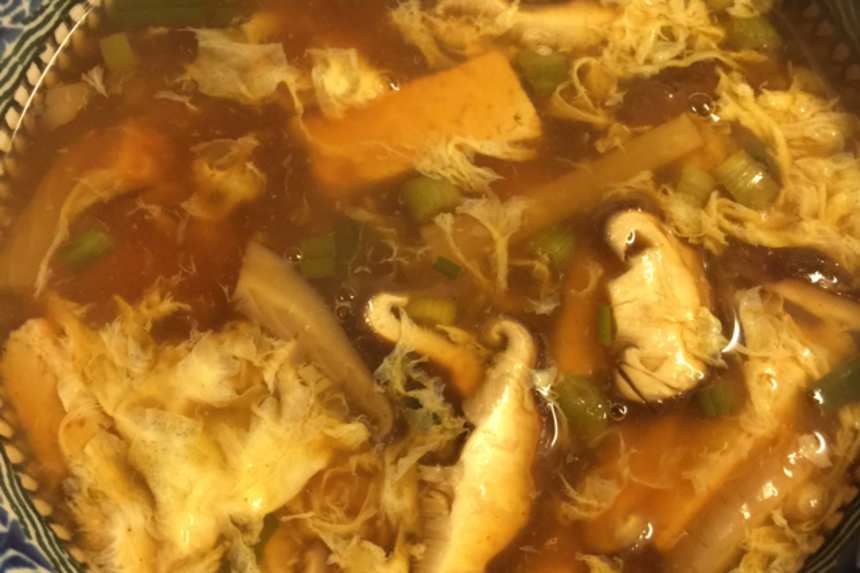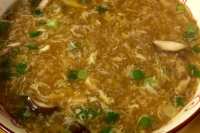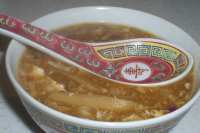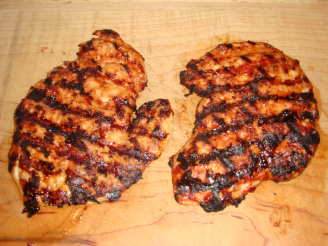Community Pick
Hot and Sour Soup (Betty Foo; Hunan Restaurant)

photo by teabluebell



- Ready In:
- 35mins
- Ingredients:
- 19
- Serves:
-
4-6
ingredients
- 1⁄2 cup dried lily buds (day lilies)
- 1⁄2 cup dried mushroom ("wood ears" or "tree ears")
- 1⁄2 lb firm tofu, julienned (this will usually be 1 block or cake of tofu)
- 3⁄4 cup pork, finely julienned (see comments for vegetarian alternative)
- 2 eggs, lightly beaten
- 1⁄2 cup bamboo shoot, julienned (canned or fresh)
- 2 tablespoons cornstarch
- 1⁄2 cup water
- 5 tablespoons distilled white vinegar
- 1⁄2 teaspoon sugar
- 5 ounces soy sauce (see comments)
- 1 teaspoon salt
- 1⁄4 teaspoon garlic powder (see comments)
- 1 teaspoon cayenne pepper, ground
- 1 teaspoon white pepper, ground
- 6 cups chicken broth (see comments for vegetarian version)
- 2 tablespoons scallions, finely chopped
- 2 tablespoons gingerroot, finely chopped
- 1 teaspoon sesame oil (optional, made from toasted sesame seeds preferred)
directions
- Clean the dried day lilies, soak them in warm water for about 20 minutes.
- Cut off the hard, tough tip of the stem and then cut the day lilies in half lengthwise.
- Clean and soak the wood ear mushrooms in warm water for about 20 minutes, then cut into small pieces. To clean, just wipe with a damp cloth -- don't soak or wash!
- Bring the chicken broth to a boil and then add the pork (or vegetarian alternative -- see below), skimming the surface of any fat.
- Cook the pork for 3-4 minutes, until the broth comes to a boil again.
- Add the tofu, mushroom pieces, bamboo shoots, and day lilies.
- Let the pot return to a boil, then reduce heat to maintain a low boil.
- Add the soy sauce, spices, vinegar, salt and sugar.
- Taste the soup, adjusting the vinegar (you may need to modify up or down by an ounce) for the "sour" and salt for balance.
- Mix the corn starch and water to create a paste for thickening.
- Add the corn starch mixture slowly, stirring constantly.
- Drizzle the beaten eggs in slowly while stirring, so that you get "strings" of egg.
- Turn off the heat.
- Presentation -- ladle the soup into bowls, then garnish with 1/2 tsp of scallion per bowl and a drizzle of sesame oil.
-
Comments on ingredients & substitutions:
- Dried lily pods and wood ears (also called "tree ears", "black fungus" or "Hu Bei") available in most oriental markets.
- Chicken stock -- use home made or a low sodium canned variety. For Vegetarians use a Vegetarian Chicken stock or a Vegetable Stock.
- Pork -- For kosher alternative, use shredded chicken or turkey; for vegetarian alternative, replace pork with a mix of fresh flavorful mushrooms, e.g., shiitake, oyster, or portobellos.
- Soy sauce -- Betty uses regular soy sauce -- if using a "lite soy" variety, you may have to adjust the amount of salt to taste.
- Vinegar -- the vinegar is the essence of the "sour" aspect of this soup, and distilled white vinegar gives you the strongest taste; rice vinegars, wine vinegars, apple cider vinegars, etc, will either be too dilute (not enough acidity) or add extraneous flavors.
- Garlic -- garlic powder is preferred in this recipe, but if you choose to use cloves, leave them whole, add them only to flavor the chicken broth and remove them before adding other ingredients.
- Sesame oil -- adds a shimmer and smoky flavor to the final product. Chinese sesame oil is typically from toasted seeds; Japanese is typically untoasted, so the flavor will be subtly different.
Questions & Replies
Got a question?
Share it with the community!
Reviews
-
I was looking for an authentic Chinese hot and sour soup recipe and this one looked like it was the real deal. And it was FANTASTIC! Now I have to admit I did not have lilly buds and in fact have never cooked with them so I'm not sure how that affects the taste. Also, the first time I served it I forgot to use a bit of sesame seed oil. Now that makes a BIG difference! Also, I used cooked pork from a loin the first time and when I wanted it again and didn't have any I used julienned roasted chicken and another time with ham. Obviously a different version but given the strong flavors of the broth base not as noticeable as one might think. I also prefer it with homemade chicken broth which tends to be a bit richer as I make it like Ina Garten with carrots, celery and onions and it has a higher fat content. I tend to put a bit more of the ginger as I like the flavor and also like diced scallions as a garnish as an alternative. Any way it's great and worth the effort and I encourage all to give it a try if you like a spicy, hot and sour soup and take out is not an option.
-
Hubby rated this AMAZING - a big thumbs up for someone who loves Chinese food!! Left out tofu, shoots because I didn't have them and ginger because hubby doesn't care for it. Used homemade chicken broth, half the cayenne and stevia to taste rather than sugar (about six drops.) Thank you so much for a keeper!!
-
I first made this soup for a birthday party and initially thought it was too vinegary. I thought that was because I didn't have white vinegar on hand and used a mix of apple cider vinegar and rice wine vinegar (I also omitted the pork to make it vegetarian). Even still by bite three I was hooked. I then made it again a week later but made sure to have the correct vinegar on hand (also used pork) and still found it delicious, but a bit too vinegary for my personal preference. It tasted amazingly good the following day though. Tonight I made it for the third time (just three weeks after having made it the first time) and omitted two tablespoons of vinegar (or one ounce) and it was the best yet. So my advice would be when making this for the first time to add a tablespoon of vinegar at a time and taste each time so that the flavor is what you want. If you like your hot and sour soup more on the vinegary side you'll probably end up sticking true to the original recipe (and it will still taste amazing) but my preference was for less. I've also never used the lily bulbs and omitted the pepper each time I've made it and couldn't tell the difference. The second and third time I also replaced corn starch for tapioca starch (I have a corn intolerance) and the consistency was fine. However you make it, it's a fantastic soup, a pain in the butt to prep, but delicious and well worth the effort.
see 19 more reviews
Tweaks
-
I first made this soup for a birthday party and initially thought it was too vinegary. I thought that was because I didn't have white vinegar on hand and used a mix of apple cider vinegar and rice wine vinegar (I also omitted the pork to make it vegetarian). Even still by bite three I was hooked. I then made it again a week later but made sure to have the correct vinegar on hand (also used pork) and still found it delicious, but a bit too vinegary for my personal preference. It tasted amazingly good the following day though. Tonight I made it for the third time (just three weeks after having made it the first time) and omitted two tablespoons of vinegar (or one ounce) and it was the best yet. So my advice would be when making this for the first time to add a tablespoon of vinegar at a time and taste each time so that the flavor is what you want. If you like your hot and sour soup more on the vinegary side you'll probably end up sticking true to the original recipe (and it will still taste amazing) but my preference was for less. I've also never used the lily bulbs and omitted the pepper each time I've made it and couldn't tell the difference. The second and third time I also replaced corn starch for tapioca starch (I have a corn intolerance) and the consistency was fine. However you make it, it's a fantastic soup, a pain in the butt to prep, but delicious and well worth the effort.
-
This is better than at a good restaurant! I followed the recipe almost to a T except that I used chili oil at the end instead of cayenne pepper, and rotisserie chicken instead of pork. Oh, and I did add shiitake and shimeji mushrooms, because I love mushrooms!! Used the white vinegar. It came out just perfect! First time making this soup and this recipe was fantastic! The hubby loved it also =) THANKS!!
-
Thank you! This soup was a total success. I also judge a restaurant by it's Hot & Sour, just like I judge a Mexican restaurant by their salsa. I decided to follow the recipe as far as vinegar and spice go, since my husband loves sour and we both love hot. Perfection! My husband even said "save this recipe", I said "I did". For those improvising, like me: I am moving and cleaning out my kitchen, so I used dried black fungus instead of mushrooms and lillies, and I had chicken instead of pork. I have full faith that next time, when I follow the recipe to the letter, it will be even better, but don't be afraid if you don't have everything. I also threw in some cilantro, but next time I will serve it on the side, so as not to over power the delicate flavor. Thank you so much for a wonderful night.
RECIPE SUBMITTED BY
Gandalf The White
Indianapolis, Indiana






